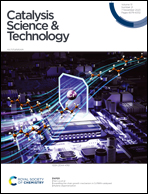Natural alternative heme-environments allow efficient peroxygenase activity by cytochrome P450 monooxygenases†
Abstract
Cytochrome P450 monooxygenases (CYPs) are biocatalysts able to catalyze a variety of regio- and stereoselective oxyfunctionalization reactions using an iron(IV)-oxo porphyrin pi-cation radical prosthetic group, commonly referred to as compound I (Cpd I). The formation of Cpd I is, however, dependent on molecular oxygen and the sequential transfer of electrons from expensive nicotinamide cofactors via additional redox partner proteins. Recently, CYPs have been engineered to introduce or enhance peroxygenase activity, whereby Cpd I is formed from H2O2. Here we explore the potential of natural CYPs containing an aspartate instead of the conventional threonine on the distal side of the heme, for peroxygenase activity. Peroxygenase activity was demonstrated with three new CYPs, with SscaCYP from Streptomyces scabiei demonstrating the highest activity towards the hydroxylation of trans-β-methyl styrene and the sulfoxidation of thioanisole. The X-ray crystal structure of SscaCYP revealed two potential acid–base catalysts (D241 and E284) in close proximity to the axial water molecule for the heterolytic O–O cleavage during H2O2 activation for Cpd I formation. Both side chain groups are also located at H2O channels to the bulk solvent. Mutagenesis of either side chain increased the peroxygenase activity, whereas removal of both abolished the peroxygenase activity of SscaCYP. Spectral analysis confirmed the tight binding of the axial water molecule when both carboxylate groups are present. With only one carboxylate group present lower concentrations of H2O2 are also required for catalysis, suggesting H2O and H2O2 exchange as a rate limiting factor in the wild-type SscaCYP. The improved peroxygenase activity and increased substrate scope of the SscaCYP variants, have identified two “hot-spots” for future protein engineering with one an alternative site for the introduction of an acid–base catalyst for engineering peroxygenase activity in other CYPs.



 Please wait while we load your content...
Please wait while we load your content...